AMD Beema/Mullins Architecture & Performance Preview
by Anand Lal Shimpi on April 29, 2014 12:00 AM ESTThe Discovery Tablet
AMD is in a difficult position these days. Traditionally it was the cheaper alternative to Intel, but with Bay Trail Intel made a serious push into segments where OEMs would traditionally use lower cost AMD silicon. In an attempt to be more than a lower cost Intel alternative, AMD is throwing its hat into the form factor reference design race and offering OEMs an example of a full, ideal, high performance implementation of its silicon. One such example is AMD’s Discovery Tablet, an 11.6-inch 1080p Windows 8.1 tablet design that features AMD’s highest end A10 Micro-6700T Mullins silicon. The tablet is a bit larger and heavier than I’d like. If AMD is going to build a reference platform I’d prefer it to be a form factor I’d actually use, which in a tablet is going to be something smaller than 11.6-inches. If you are trying to cover both tablet and 2-in-1 form factors however, the Discovery Tablet makes sense.
I was allowed to spend a few hours benchmarking AMD’s Discovery Tablet. Unfortunately the device wasn’t instrumented for power testing, nor was there enough time to run any battery life tests on it, so the usefulness of these numbers is limited. We already know that AMD’s idle power isn’t as good as smartphone silicon, but for some of these value Windows 8.1 devices it may still be good enough.
Tablet JS/Web Browser Tests
We'll start with our usual set of JavaScript tests. Here we see AMD's A10 Micro-6700T outperform everything on the list. Whether we're talking about Bay Trail or Apple's A7, the 6700T pulls ahead by a decent margin. Once again the big question is how much power is being drawn to deliver this performance. Unlike Intel's Bay Trail preview, AMD didn't have any instrumented Discovery tablets setup for us to monitor power consumption. I suspect AMD's power consumption is competitive, but my guess is it isn't similarly class leading.
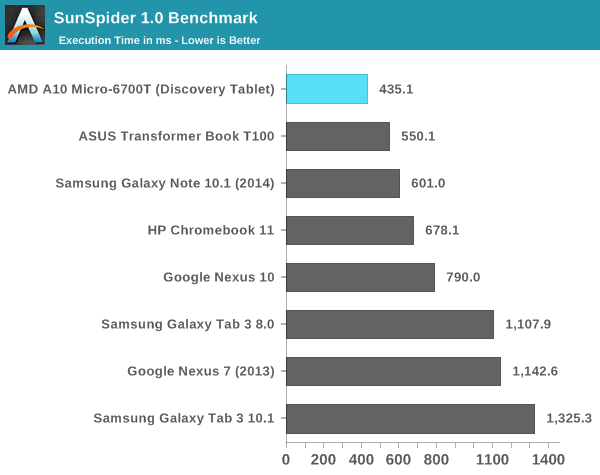
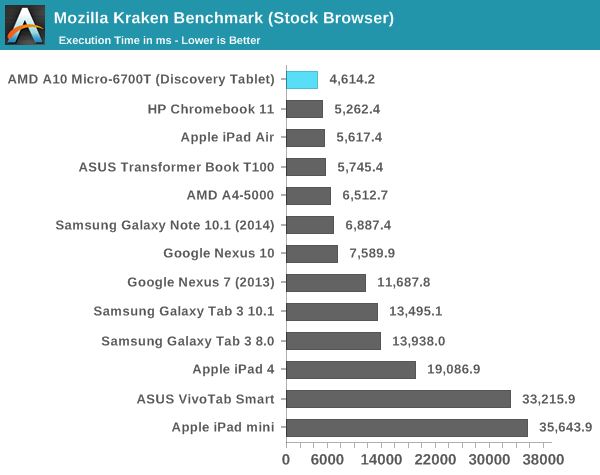

CPU Performance
For these next tests I turned to some of our more traditional Windows PC benchmarks. I looked at Cinebench 11.5 to get an idea for how single and multithreaded performance have changed since last year.
Looking at single threaded performance we immediately see the benefits of AMD's new boosting capabilities. The Puma+ cores are 35% faster than Intel's Silvermont cores, and can deliver nearly 80% of the performance of AMD's Piledriver cores found in Trinity. I threw some Llano results in here as well - Mullins offers around 85% of the performance of Llano.
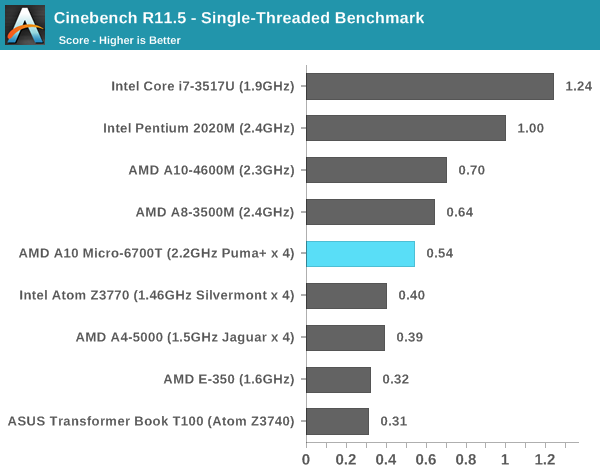
Multithreaded performance is pretty evenly matched between Bay Trail and Mullins here. Note that Mullins manages to deliver very similar performance to Kabini, despite coming in at substantially less power. The comparison to Brazos (E-350) is laughable, Mullins is substantially faster.
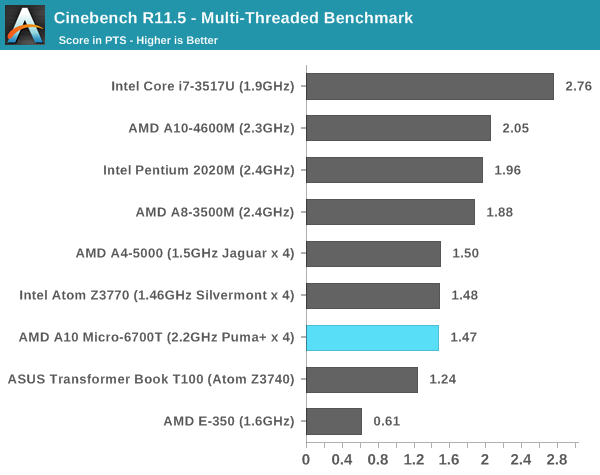
PCMark 7 gives us a better look at the overall performance of the Discovery tablet hardware. Here we do see it lose ground to the Kabini notebook (A4-5000) as well as the Bay Trail devices. It's unclear to me if we are seeing the thermal limits of the hardware (this is a longer test) or if there are other elements at work here (e.g. storage performance limits).
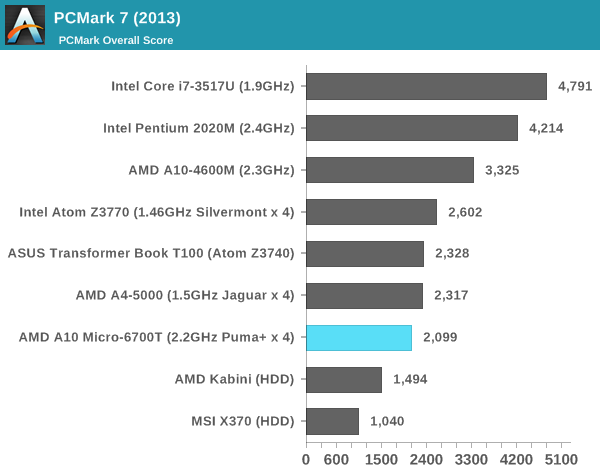
GPU Performance
We don’t actually have any Bay Trail devices in our Laptop 2013 bench, they are all in our Tablet 2013 category, which unfortunately uses different benchmarks. To make a long story short, we have Bay Trail vs. Kabini data, and Kabini vs. Mullins data. Thankfully the comparison between Bay Trail and Mullins is pretty easy to make.
AMD’s 4.5W TDP A10 Micro-6700T delivers roughly the same GPU performance as a 15W A4-5000. The A4-5000 also ends up being anywhere from 50% to over 2x the speed of Bay Trail when it comes to GPU performance, so you can expect Mullins to hold roughly the same advantage.
Compared to the old 35W Trinity, Mullins still has a ways to go. Trinity delivers roughly 2x the performance of Mullins, although at nearly 10x the TDP.
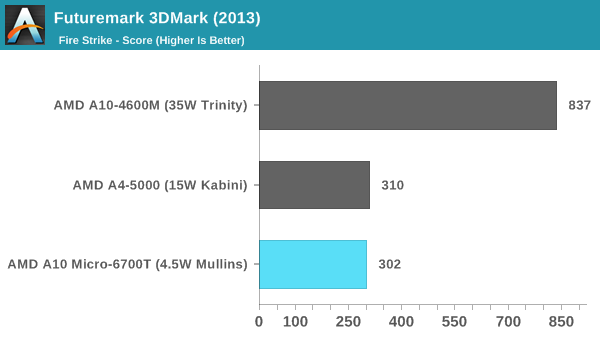
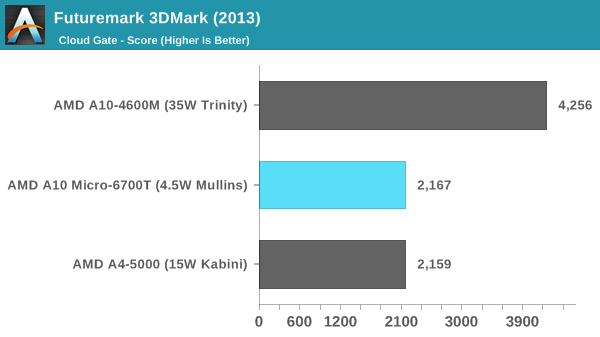
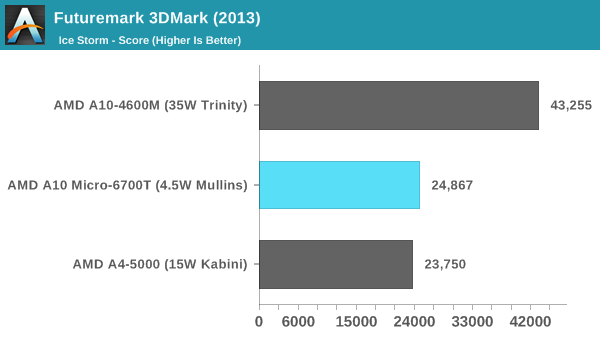


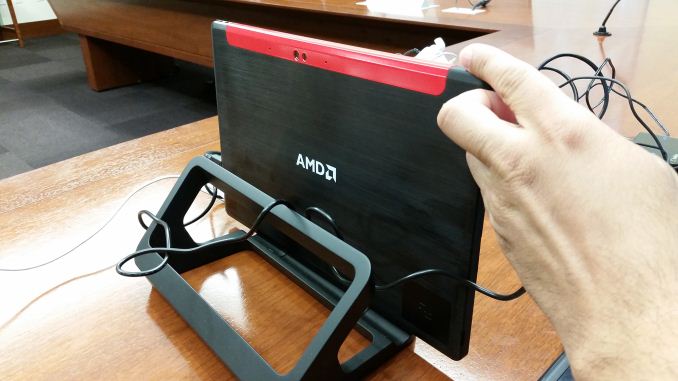
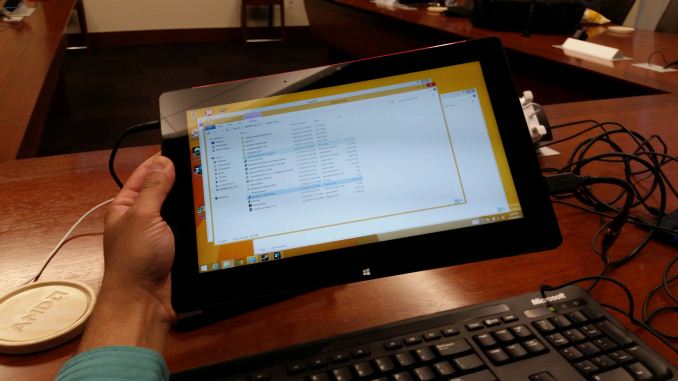














82 Comments
View All Comments
superunknown98 - Tuesday, April 29, 2014 - link
Although I don't think it would happen, or at least be publicly announced, Microsoft could use these new cores in Xbox One but could only enable turbo for the two cores that run the virtualization and Xbox OS. They would also benefit from the reduced TDP, which is something that eventually happens at some point anyway.lmcd - Thursday, May 1, 2014 - link
Now that comment on the OS and virtualization cores was quite interesting. I now thing that a Puma-edition is likely (though I think a GPU switch-up is more likely if more efficient GCN variants occur.MikeMurphy - Monday, May 26, 2014 - link
No sense revising an entire chip to save a few watts of power. They might revise it later provided that substantial power savings are attainable, otherwise will implement the usual die shrinks. Minor performance increases shouldn't be ruled out although focus will be on power reduction while maintaining similar performance.Rockmandash12 - Tuesday, April 29, 2014 - link
And this is what happens when AMD gets into gear and makes a new architecture. Real improvement that's competitive with rivals. Common.... new Desktop flagship architecture that's faster and more efficient? please?Samus - Wednesday, April 30, 2014 - link
This is pretty impressive. And honestly, out of nowhere. They all the sudden have an amazing tablet/uSFF SoC.silverblue - Tuesday, April 29, 2014 - link
Didn't Kaveri launch with a fully enabled PSP as well?Judging by the performance story thus far, I think it will put to bed the calls for cat cores to replace AMD's higher powered offerings. Yes, we're past K8 performance levels now, but Llano and Trinity (let alone Richland/Kaveri) still have it beat. You'd need some serious clock speeds to get decent performance and it's the wrong silicon for that.
I was disappointed to see that it's practically the same uarch as Jaguar, meaning we're still going to have a single channel memory controller, however the performance and power improvements are substantial, and the memory controller has been improved anyway which should reduce the need for said controller.
ET - Tuesday, April 29, 2014 - link
I think it's hard to draw conclusions of core performance when the RAM is a limitation. It's entirely possible that these cores are still pretty far from the big cores, but on the other hand it's possible that more bandwidth could up performance by quite a few percent.ssnitrousoxide - Tuesday, April 29, 2014 - link
AMD has always done some impressive work to squeeze every bit of performance from an inferior node. How they managed to improve energy efficiency so much is beyond me.mfoley93 - Wednesday, April 30, 2014 - link
It seems that most of the power reduction is at the manufacturing level; maybe it's more accurate to engineering tolerances or perhaps a more pure silicon, either way I don't think TSMC will be telling us what it is. The rest comes from eliminating circuitry that provides some more flexibility to OEMs, something nVIDIA has been doing for a couple years now, and while it doesn't reallycount, it's something Apple does very well.
yannigr - Tuesday, April 29, 2014 - link
Any idea if Beema will be compatible with existing AM1 motherboards?(with only a BIOS update of course)